belt SKODA ROOMSTER 2006 1.G Owner's Guide
[x] Cancel search | Manufacturer: SKODA, Model Year: 2006, Model line: ROOMSTER, Model: SKODA ROOMSTER 2006 1.GPages: 274, PDF Size: 48.64 MB
Page 152 of 274
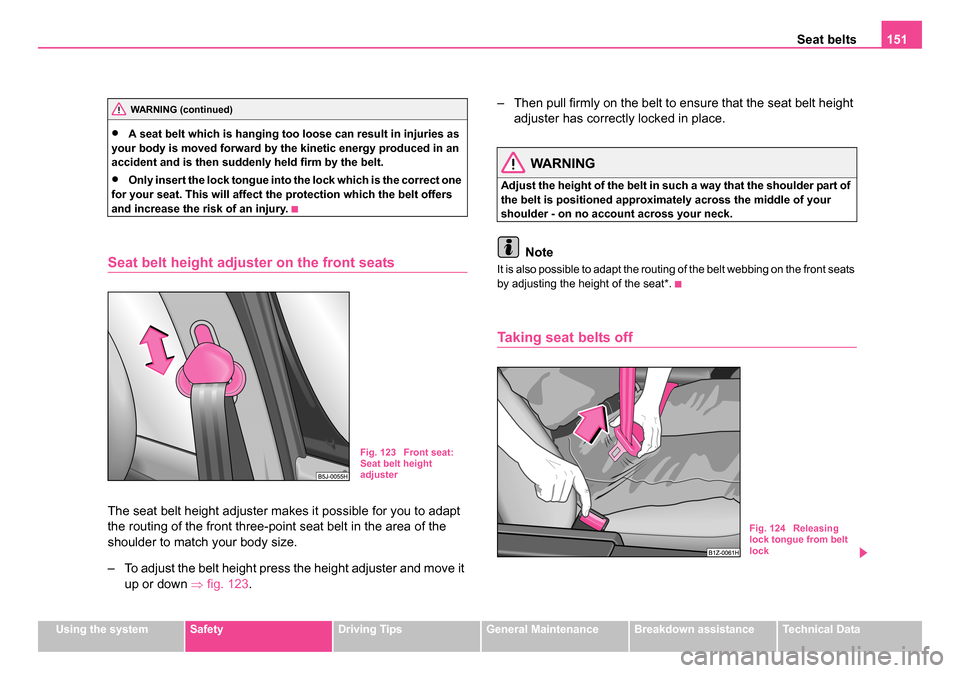
Seat belts151
Using the systemSafetyDriving TipsGeneral MaintenanceBreakdown assistanceTechnical Data
•A seat belt which is hanging too loose can result in injuries as
your body is moved forward by the kinetic energy produced in an
accident and is then suddenly held firm by the belt.
•Only insert the lock tongue into the lock which is the correct one
for your seat. This will affect the protection which the belt offers
and increase the risk of an injury.
Seat belt height adju ster on the front seats
The seat belt height adjuster makes it possible for you to adapt
the routing of the front three-point seat belt in the area of the
shoulder to match your body size.
– To adjust the belt height press the height adjuster and move it
up or down ⇒fig. 123 . – Then pull firmly on the belt to ensure that the seat belt height
adjuster has correctly locked in place.
WARNING
Adjust the height of the belt in such a way that the shoulder part of
the belt is positioned approximately across the middle of your
shoulder - on no account across your neck.
Note
It is also possible to adapt the routing of the belt webbing on the front seats
by adjusting the height of the seat*.
Taking seat belts off
WARNING (continued)
Fig. 123 Front seat:
Seat belt height
adjuster
Fig. 124 Releasing
lock tongue from belt
lock
NKO 20 A05.book Page 151 Wednesday, June 21, 2006 1:42 PM
Page 153 of 274

Seat belts
152
– Press the red button in the belt lock ⇒fig. 124 . The spring
force causes the tongue of the lock to jump out.
– Guide the belt back with your hand to enable the inertia reel to wind up the belt webbing more easily.
A plastic knob in the belt webbing holds the belt tongue in a position which
is easy to get hold of.
Three-point seat belt fo r the rear middle seat
The three-point seat belt for the rear middle seat is
anchored in the area of the luggage compartment on the
left side of the headliner.
Your car is equipped as standard with the three-point seat belt
Fastening the seat belt
– Pull the belt with both lock tongues out of the headliner mount.
– Insert the lock tongue at the end of the belt into the seat belt buckle on the left side until it is heard to lock in place.
– Pull the second lock tongue, which is moveable on the seat belt, over the chest and insert it into the belt buckle on the right
side until it is heard to lock in place.
– Pull on the belt to check that both lock tongues are reliably engaged in the locks. – The belt tongues for the rear middle seat are shaped differ-
ently so that they only fit into the respective belt buckle. If you
attempt to insert a lock tongue into the wrong belt lock it will
not lock.
Taking seat belt off
– Take off the seat belt in the reverse order to fastening.
WARNING
•The three-point safety belt for the rear middle seat can only fulfil
its function reliably when the backrests are correctly locked into
position ⇒page 72.
•After releasing the seat belt hold it tight and let it slowly reel up
until both lock tongues lock into the headliner mount and are
secured with a magnet - risk of injury.
•Never release simultaneously both tongues of the lock.
Belt tensioner
Safety for the driver and front passenger wearing their seat belts is
enhanced by the belt tensioners fitted to the inertia reels of the front three-
point seat belts.
The fastened three-point seat belts are automatically tensioned in the
event of a frontal collision of a certain severity. The belts tensioners are
also deployed if the seat belts are not fastened.
Belt tensioners are not activated in the event of minor frontal collisions,
side and rear-end collisions, in the case of a rollover and also not in acci-
dents in which no major forces are produced from the front.
NKO 20 A05.book Page 152 Wednesday, June 21, 2006 1:42 PM
Page 154 of 274

Seat belts153
Using the systemSafetyDriving TipsGeneral MaintenanceBreakdown assistanceTechnical Data
WARNING
•Any work on the belt tightener system, including removal and
installation of system components because of other repair work,
must only be carried out by a specialist garage.
•The protective function of the system is only adequate for a
single accident. If the belt tensioners have been deployed, it is then
necessary to replace the entire system.
•The Owner's Manual must also be handed over to the new
owner if the vehicle is sold.
Note
•Smoke is generated when the belt tensioners are deployed. This is not
an indication of a fire in the vehicle.
•It is essential to pay attention to relevant safety regulations if the
vehicle or individual parts of the system are scrapped. Škoda Service
Partners are familiar with these regulations and will be able to provide you
with detailed information in this respect.
•When disposing of vehicle or parts of the system, it is important to
comply with the national legal requirements.
NKO 20 A05.book Page 153 Wednesday, June 21, 2006 1:42 PM
Page 155 of 274
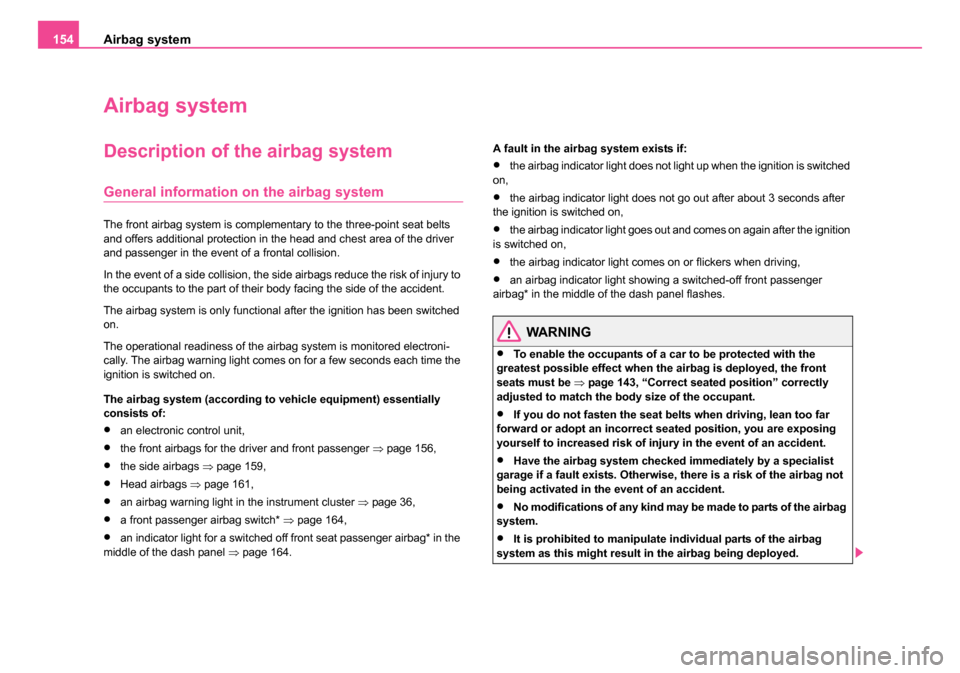
Airbag system
154
Airbag system
Description of the airbag system
General information on the airbag system
The front airbag system is complementary to the three-point seat belts
and offers additional protection in the head and chest area of the driver
and passenger in the event of a frontal collision.
In the event of a side collision, the side airbags reduce the risk of injury to
the occupants to the part of their body facing the side of the accident.
The airbag system is only functional after the ignition has been switched
on.
The operational readiness of the airbag system is monitored electroni-
cally. The airbag warning light comes on for a few seconds each time the
ignition is switched on.
The airbag system (according to vehicle equipment) essentially
consists of:
•an electronic control unit,
•the front airbags for the driver and front passenger ⇒page 156,
•the side airbags ⇒page 159,
•Head airbags ⇒page 161,
•an airbag warning light in the instrument cluster ⇒page 36,
•a front passenger airbag switch* ⇒page 164,
•an indicator light for a switched off front seat passenger airbag* in the
middle of the dash panel ⇒page 164. A fault in the airbag system exists if:
•the airbag indicator light does not light up when the ignition is switched
on,
•the airbag indicator light does not go out after about 3 seconds after
the ignition is switched on,
•the airbag indicator light goes out and comes on again after the ignition
is switched on,
•the airbag indicator light comes on or flickers when driving,
•an airbag indicator light showing a switched-off front passenger
airbag* in the middle of the dash panel flashes.
WARNING
•To enable the occupants of a car to be protected with the
greatest possible effect when the airbag is deployed, the front
seats must be ⇒page 143, “Correct seated position” correctly
adjusted to match the body size of the occupant.
•If you do not fasten the seat belts when driving, lean too far
forward or adopt an incorrect seated position, you are exposing
yourself to increased risk of injury in the event of an accident.
•Have the airbag system checked immediately by a specialist
garage if a fault exists. Otherwise, there is a risk of the airbag not
being activated in the event of an accident.
•No modifications of any kind may be made to parts of the airbag
system.
•It is prohibited to manipulate individual parts of the airbag
system as this might result in the airbag being deployed.
NKO 20 A05.book Page 154 Wednesday, June 21, 2006 1:42 PM
Page 157 of 274
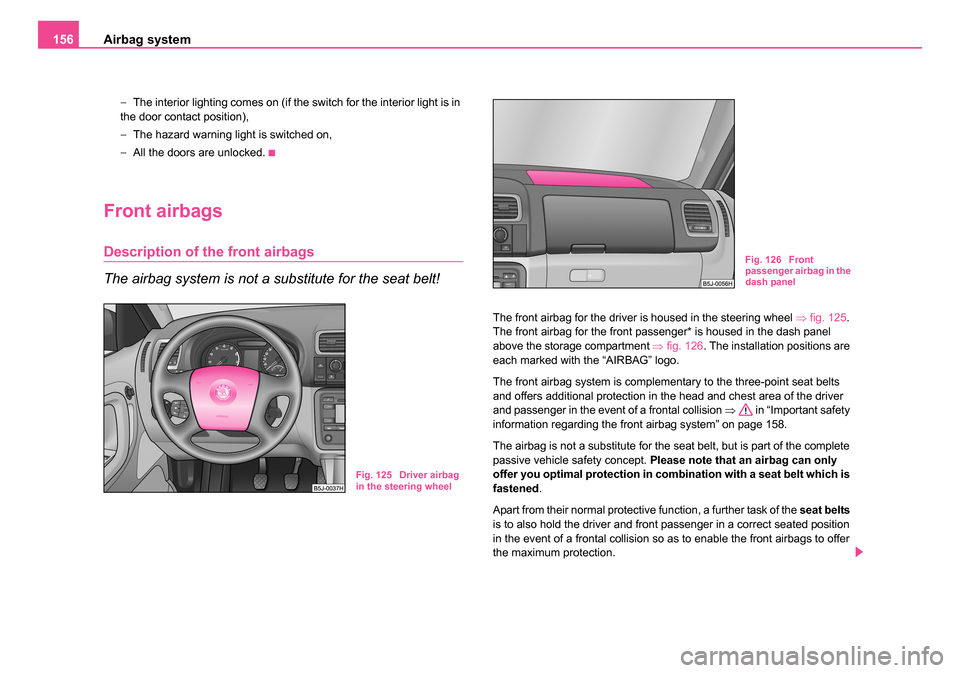
Airbag system
156
− The interior lighting comes on (if the switch for the interior light is in
the door contact position),
− The hazard warning light is switched on,
− All the doors are unlocked.
Front airbags
Description of the front airbags
The airbag system is not a substitute for the seat belt!
The front airbag for the driver is housed in the steering wheel ⇒fig. 125 .
The front airbag for the front passenger* is housed in the dash panel
above the storage compartment ⇒fig. 126 . The installation positions are
each marked with the “AIRBAG” logo.
The front airbag system is complementary to the three-point seat belts
and offers additional protection in the head and chest area of the driver
and passenger in the event of a frontal collision ⇒ in “Important safety
information regarding the front airbag system” on page 158.
The airbag is not a substitute for the seat belt, but is part of the complete
passive vehicle safety concept. Please note that an airbag can only
offer you optimal protection in combination with a seat belt which is
fastened .
Apart from their normal protective function, a further task of the seat belts
is to also hold the driver and front passenger in a correct seated position
in the event of a frontal collision so as to enable the front airbags to offer
the maximum protection.
Fig. 125 Driver airbag
in the steering wheel
Fig. 126 Front
passenger airbag in the
dash panel
NKO 20 A05.book Page 156 Wednesday, June 21, 2006 1:42 PM
Page 158 of 274
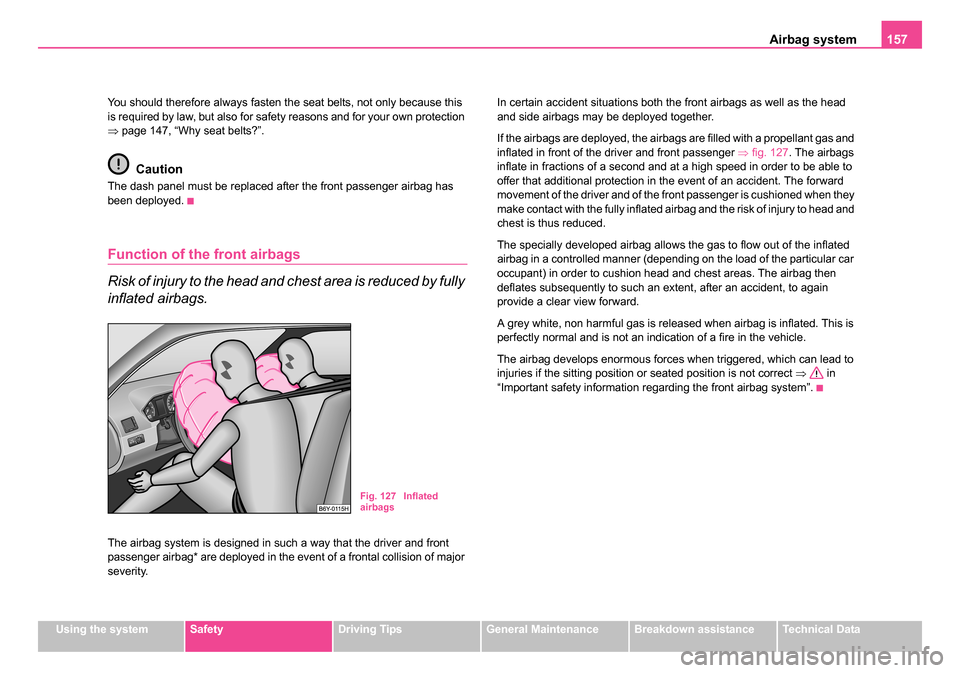
Airbag system157
Using the systemSafetyDriving TipsGeneral MaintenanceBreakdown assistanceTechnical Data
You should therefore always fasten the seat belts, not only because this
is required by law, but also for safety reasons and for your own protection
⇒
page 147, “Why seat belts?”.
Caution
The dash panel must be replaced after the front passenger airbag has
been deployed.
Function of the front airbags
Risk of injury to the head and chest area is reduced by fully
inflated airbags.
The airbag system is designed in such a way that the driver and front
passenger airbag* are deployed in the event of a frontal collision of major
severity. In certain accident situations both the front airbags as well as the head
and side airbags may be deployed together.
If the airbags are deployed, the airbags are filled with a propellant gas and
inflated in front of the driver and front passenger
⇒fig. 127 . The airbags
inflate in fractions of a second and at a high speed in order to be able to
offer that additional protection in the event of an accident. The forward
movement of the driver and of the front passenger is cushioned when they
make contact with the fully inflated airbag and the risk of injury to head and
chest is thus reduced.
The specially developed airbag allows the gas to flow out of the inflated
airbag in a controlled manner (depending on the load of the particular car
occupant) in order to cushion head and chest areas. The airbag then
deflates subsequently to such an extent, after an accident, to again
provide a clear view forward.
A grey white, non harmful gas is released when airbag is inflated. This is
perfectly normal and is not an indication of a fire in the vehicle.
The airbag develops enormous forces when triggered, which can lead to
injuries if the sitting position or seated position is not correct ⇒ in
“Important safety information regarding the front airbag system”.
Fig. 127 Inflated
airbags
NKO 20 A05.book Page 157 Wednesday, June 21, 2006 1:42 PM
Page 160 of 274

Airbag system159
Using the systemSafetyDriving TipsGeneral MaintenanceBreakdown assistanceTechnical Data
Side airbags*
Description of side airbags
The side airbag increases protection of the passenger
concerned in the case of a side impact.
The side airbags are housed in the upholstery of the backrests of the front
seats and are marked ⇒fig. 129 with the lettering “AIRBAG” on the
middle part.
The side airbag system in combination with the three-point seat belts,
offers additional protection for the upper area of the body (chest, stomach
and pelvis) in the event of severe side collisions ⇒ in “Important safety
information on the side airbag” on page 160.
Apart from their normal protective function, a further task of the seat belts
is to also hold the driver and front passenger in a correct seated position
in the event of a side collision so as to enable the side airbags to offer the
maximum protection. You should therefore always fasten the seat belts, not only because this
is required by law, but also for safety reasons and for your own protection
⇒
page 147, “Why seat belts?”.
Function of the side airbags
Risk of injury to the upper part of the body is reduced by
fully inflated side airbags.
In the case of a violent side crash , the side airbags in the front seat and
the head airbags on the side of the car at which the collision occurs, are
deployed ⇒fig. 130 .
In certain accident situations both the front airbags as well as the head
and side airbags may be deployed together.
If an airbag is deployed, the airbag is filled with propellant gas. The
airbags inflate in fractions of a second and at a high speed in order to be
able to offer that additional protection in the event of an accident.
Fig. 129 Driver seat:
Installation position of
airbag
Fig. 130 Side airbags
deployed
NKO 20 A05.book Page 159 Wednesday, June 21, 2006 1:42 PM
Page 162 of 274
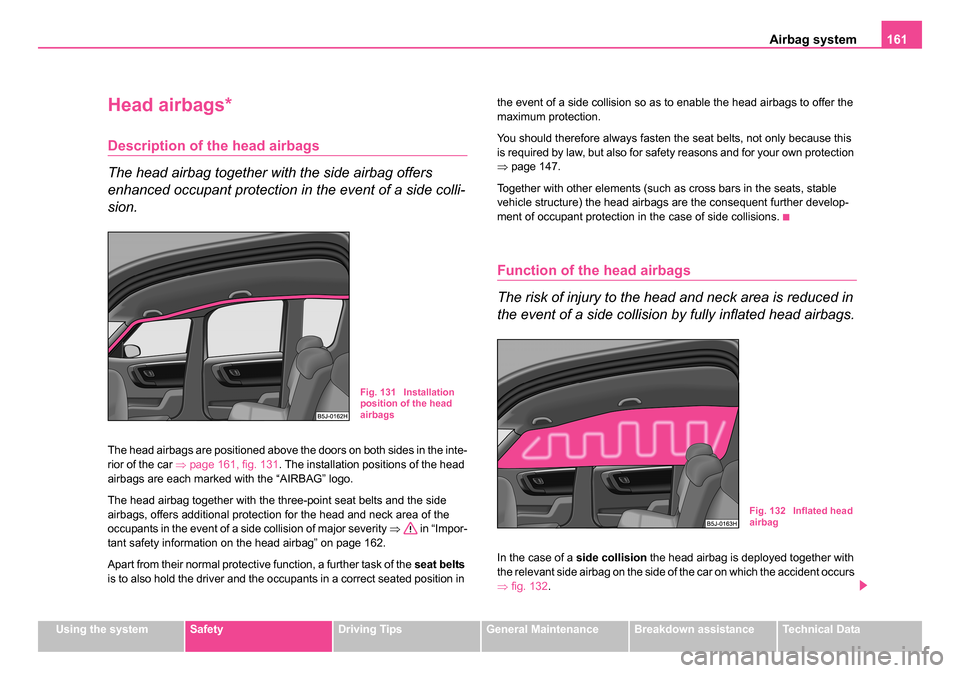
Airbag system161
Using the systemSafetyDriving TipsGeneral MaintenanceBreakdown assistanceTechnical Data
Head airbags*
Description of the head airbags
The head airbag together with the side airbag offers
enhanced occupant protection in the event of a side colli-
sion.
The head airbags are positioned above the doors on both sides in the inte-
rior of the car ⇒page 161, fig. 131 . The installation positions of the head
airbags are each marked with the “AIRBAG” logo.
The head airbag together with the three-point seat belts and the side
airbags, offers additional protection for the head and neck area of the
occupants in the event of a side collision of major severity ⇒ in “Impor-
tant safety information on the head airbag” on page 162.
Apart from their normal protective function, a further task of the seat belts
is to also hold the driver and the occupants in a correct seated position in the event of a side collision so as to enable the head airbags to offer the
maximum protection.
You should therefore always fasten the seat belts, not only because this
is required by law, but also for safety reasons and for your own protection
⇒
page 147.
Together with other elements (such as cross bars in the seats, stable
vehicle structure) the head airbags are the consequent further develop-
ment of occupant protection in the case of side collisions.
Function of the head airbags
The risk of injury to the head and neck area is reduced in
the event of a side collision by fully inflated head airbags.
In the case of a side collision the head airbag is deployed together with
the relevant side airbag on the side of the car on which the accident occurs
⇒ fig. 132 .
Fig. 131 Installation
position of the head
airbags
Fig. 132 Inflated head
airbag
NKO 20 A05.book Page 161 Wednesday, June 21, 2006 1:42 PM
Page 167 of 274
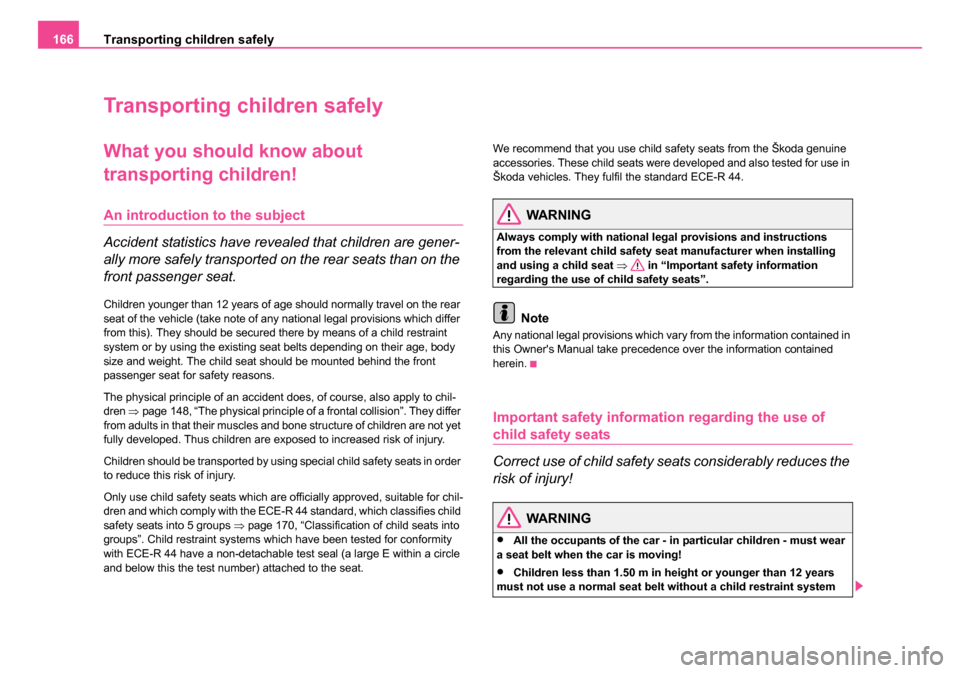
Transporting children safely
166
Transporting children safely
What you should know about
transporting children!
An introduction to the subject
Accident statistics have revealed that children are gener-
ally more safely transported on the rear seats than on the
front passenger seat.
Children younger than 12 years of age should normally travel on the rear
seat of the vehicle (take note of any national legal provisions which differ
from this). They should be secured there by means of a child restraint
system or by using the existing seat belts depending on their age, body
size and weight. The child seat should be mounted behind the front
passenger seat for safety reasons.
The physical principle of an accident does, of course, also apply to chil-
dren ⇒page 148, “The physical principle of a frontal collision”. They differ
from adults in that their muscles and bone structure of children are not yet
fully developed. Thus children are exposed to increased risk of injury.
Children should be transported by using special child safety seats in order
to reduce this risk of injury.
Only use child safety seats which are officially approved, suitable for chil-
dren and which comply with the ECE-R 44 standard, which classifies child
safety seats into 5 groups ⇒page 170, “Classification of child seats into
groups”. Child restraint systems which have been tested for conformity
with ECE-R 44 have a non-detachable test seal (a large E within a circle
and below this the test number) attached to the seat. We recommend that you use child safety seats from the Škoda genuine
accessories. These child seats were developed and also tested for use in
Škoda vehicles. They fulfil the standard ECE-R 44.
WARNING
Always comply with national le
gal provisions and instructions
from the relevant child safety seat manufacturer when installing
and using a child seat ⇒ in “Important safety information
regarding the use of child safety seats”.
Note
Any national legal provisions which vary from the information contained in
this Owner's Manual take precedence over the information contained
herein.
Important safety informatio n regarding the use of
child safety seats
Correct use of child safety seats considerably reduces the
risk of injury!
WARNING
•All the occupants of the car - in particular children - must wear
a seat belt when the car is moving!
•Children less than 1.50 m in height or younger than 12 years
must not use a normal seat belt without a child restraint system
NKO 20 A05.book Page 166 Wednesday, June 21, 2006 1:42 PM
Page 168 of 274
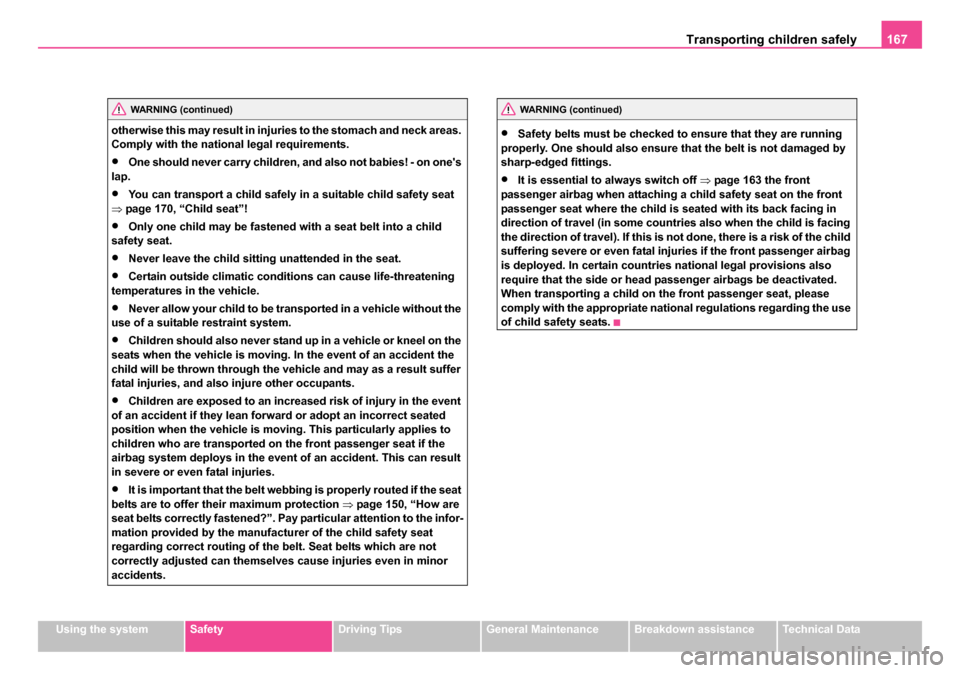
Transporting children safely 167
Using the systemSafetyDriving TipsGeneral MaintenanceBreakdown assistanceTechnical Data
otherwise this may result in injuries to the stomach and neck areas.
Comply with the national legal requirements.
•One should never carry children, and also not babies! - on one's
lap.
•You can transport a child safely in a suitable child safety seat
⇒ page 170, “Child seat”!
•Only one child may be fastened with a seat belt into a child
safety seat.
•Never leave the child sitting unattended in the seat.
•Certain outside climatic conditions can cause life-threatening
temperatures in the vehicle.
•Never allow your child to be tran sported in a vehicle without the
use of a suitable restraint system.
•Children should also never stand up in a vehicle or kneel on the
seats when the vehicle is moving. In the event of an accident the
child will be thrown through the vehicle and may as a result suffer
fatal injuries, and also injure other occupants.
•Children are exposed to an increased risk of injury in the event
of an accident if they lean forward or adopt an incorrect seated
position when the vehicle is moving . This particularly applies to
children who are transported on the front passenger seat if the
airbag system deploys in the event of an accident. This can result
in severe or even fatal injuries.
•It is important that the belt webb ing is properly routed if the seat
belts are to offer their maximum protection ⇒page 150, “How are
seat belts correctly fastened?”. Pay particular attention to the infor-
mation provided by the manufacturer of the child safety seat
regarding correct routing of the belt. Seat belts which are not
correctly adjusted can themselves cause injuries even in minor
accidents.
•Safety belts must be checked to ensure that they are running
properly. One should also ensure that the belt is not damaged by
sharp-edged fittings.
•It is essential to always switch off ⇒page 163 the front
passenger airbag when attaching a child safety seat on the front
passenger seat where the child is seated with its back facing in
direction of travel (in some countries also when the child is facing
the direction of travel). If this is not done, there is a risk of the child
suffering severe or even fatal injuries if the front passenger airbag
is deployed. In certain countries national legal provisions also
require that the side or head passenger airbags be deactivated.
When transporting a child on the front passenger seat, please
comply with the appropriate national regulations regarding the use
of child safety seats.
WARNING (continued)WARNING (continued)
NKO 20 A05.book Page 167 Wednesday, June 21, 2006 1:42 PM